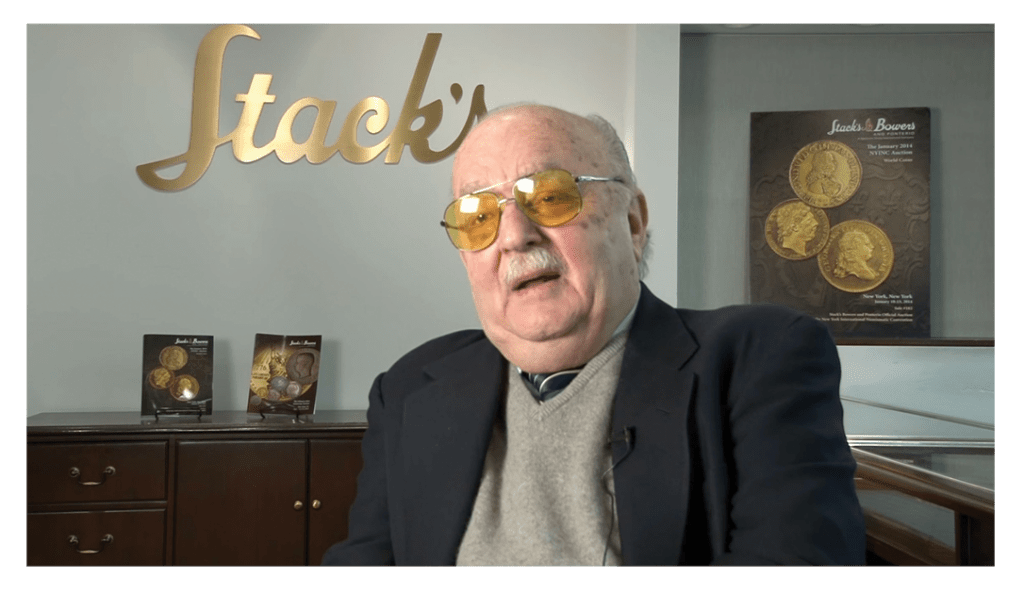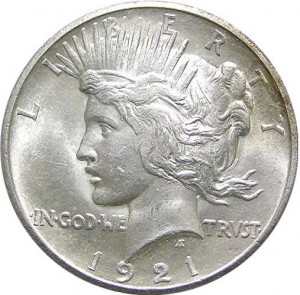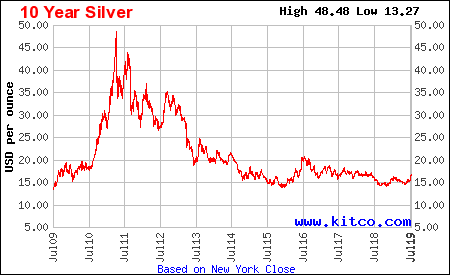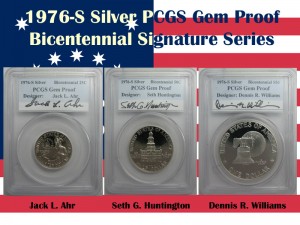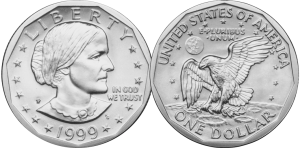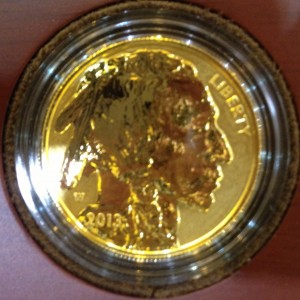Remembering Harvey G. Stack – 1928-2022
My thoughts will be below the announcement.
It is with great sadness we announce the passing of our friend and founder, Harvey G. Stack on January 3, 2022. His leadership over the years spearheaded our operations and his kindness and mentorship to staff, collectors, dealers, numismatic organizations and colleagues will never be forgotten.
Harvey was born in Manhattan on June 3, 1928, the son of Morton M. Stack and Muriel Stack. He grew up in Bronx and Jamaica, New York and attended NYU. His life revolved around his family and around numismatics, as generations of the Stack family built upon the rare coin business founded in 1933 by Harvey’s father, Morton, and his uncle Joseph at 690 Sixth Avenue in Manhattan. Presenting their first public auction in 1935, Stack’s quickly progressed to larger premises and a growing reputation. Although as a youngster Harvey worked after school and during vacations at the firm’s Manhattan coin store, it wasn’t until 1947 that he went to work full time for Stack’s Rare Coins, a career that would last more than 70 years. As one of the second generation of family members to join the firm, Harvey worked alongside his father, uncle, and cousins Norman and Benjamin, supported by a staff of experts that comprised many of the most well-known professional numismatists of the 20th century.
In 1953 Stack’s moved to a gallery at 123 West 57th Street, a location that would be home to the firm for more than 60 years and become a popular destination, known as the “clubhouse” for collectors from all over the world. As a family member, Harvey’s responsibilities were wide ranging, assisting clients in the store, traveling to pick up collections and attend conventions and coin shows, cataloging auction lots, auctioneering, and any other work that needed to be done. He became an expert in many areas of numismatics and was able to translate his warm and jovial personality into long-term relationships with the collectors and dealers he worked with over his career.
The decades following World War II were times of great growth for Stack’s. Besides opening a new and improved location, they were tapped to present at auction many important collections including Anderson-Dupont, Davis-Graves, Charles A. Cass (“Empire”), R.L. Miles, Massachusetts Historical Society, Samuel Wolfson, and George Walton, as well as conducting public auctions in conjunction with major numismatic shows including the American Numismatic Association and the Metropolitan New York conventions. In the 1970s, Harvey’s son Larry and daughter Susan joined the firm, bringing in a third generation.
Harvey and the Stack family were instrumental in building some of the greatest collections of their time, including the cabinet of gold coins assembled by Josiah K. Lilly, chairman of the Eli Lilly & Co. pharmaceutical company. After Lilly’s death in 1966, his collection of over 6,000 coins became part of the National Numismatic Collection at the Smithsonian, a process aided by Harvey and other members of the Stack family. Over the decades, Harvey and the Stack family also built a relationship with Louis E. Eliasberg, Sr., who accumulated the only complete collection of United States coins ever formed. In 1976, when the nation was celebrating its Bicentennial, Harvey and the firm helped facilitate the display of Eliasberg’s incomparable collection at the United States Mint in Philadelphia.
Harvey Stack’s role in numismatics was not purely business. He fought for clearer import regulations on coins from overseas and testified before a congressional subcommittee leading up to the Hobby Protection Act of 1973. He worked with the American Numismatic Association and other professionals in the effort to develop a standardized grading system for coins. In 1996 he appeared before the U.S. House Banking Committee to propose the 50 State Quarters Program, which brought countless new collectors into the hobby. Harvey Stack served on the board of the Professional Numismatists Guild for nearly a decade and acted as its president for two years beginning in 1989. In 1993 he received the PNG’s Founder’s Award, their highest honor, for his dedication to the hobby. Over the years, Harvey was a great supporter of the American Numismatic Association, the American Numismatic Society, and the Smithsonian Institution. He was a long-term member of the International Association of Professional Numismatists, as well as numerous other numismatic societies.
As the 20th century turned to the 21st, Harvey Stack and Stack’s were still going strong, as Larry and Harvey brought to auction the incredible John J. Ford, Jr. Collection, and many other famous name cabinets. In addition, they partnered with Sotheby’s in the record-breaking sale of the first 1933 Saint-Gaudens double eagle to cross the auction block. In 2011, Stack’s merged with Bowers and Merena to create Stack’s Bowers Galleries, one of the top numismatic auction firms in the country and a company that continues the Stack family’s legacy of presenting important numismatic cabinets and realizing record-breaking prices. Harvey remained involved in the new business until the very end, telling the company’s history, mentoring staff members, and maintaining his relationships within the hobby. Most recently he and Larry worked with the estate of long-time friends and clients Mark and Lottie Salton to bring their outstanding collection of world and ancient coins to market. It is unfortunate that Harvey will not be there to see the fruits of his labor as this remarkable cabinet crosses the auction block in 2022 and 2023.
Harvey was predeceased by his parents, his uncle Joseph, his cousins Norman and Ben. He is survived by his wife, Harriet, children Larry (Loretta) and Susan (Larry), grandchildren Rebecca (Jimmy) and Matthew (Tanya), and five great-grandchildren: Bryce, Avery, Dylan, Brielle and James.
Services will be private. In lieu of flowers, donations can be made to the Leukemia & Lymphoma Society, the American Numismatic Society or a charity of choice.
Personal Remembrance
I met Harvey Stack for the first time in 1971 at their 57th Street store in Manhattan. There was no formal “take your child to work” program in those days. My father would take me into the city with him one day a year, and they would give me busy work to do when I was not doing my homework. But the fun was around lunchtime.
After grabbing a sandwich, we would walk over to Stack’s to look at the coins and buy a few. It did not matter if you were coming with your father, an experienced collector, or even if you were a change picker. Everyone was welcome at Stack’s.
The first time I visited the store, there was a lot of activity. A lot of people were talking about and looking at coins. I remember that Harvey Stack was presiding over the gaggle. When he saw my father and me, he came over to help us. Aside from helping me pick out two Roosevelt Dimes for my collection, he taught me what to look for in a good dime. It was the first time I saw a Buffalo nickel.
We left that day with the dimes, a few Buffalo nickels, a Whitman Classic Album for the nickels, and a new Red Book. It was more than my father wanted to pay, but he knew it would keep me occupied all afternoon.
We lived in New York for two more years before moving. I continued to visit Stack’s when I was in the area. The store always had a lot of activity, but Harvey Stack had slowed down in the last few years.
Stack’s was the first dealer I visited, and I will never forget Harvey Stack for helping me get started.
Weekly World Numismatic News for August 4, 2019
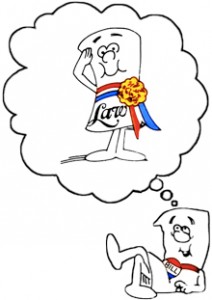 Congress is nothing if not full of shallow people who would pander to their own mothers if it meant winning a vote or two. Their shallowness is on display just before they go on an extended break when members drop bills into the virtual hopper for consideration.
Congress is nothing if not full of shallow people who would pander to their own mothers if it meant winning a vote or two. Their shallowness is on display just before they go on an extended break when members drop bills into the virtual hopper for consideration.
In the old days, members of Congress would write have the bills printed on paper and dropped into a physical hopper. The Clerk of the House would empty the hopper and enter new bills into the Congressional Record and add it to the calendar. The bills are sent to the Government Printing Office (GPO) for publications. Nowadays, the hopper is virtual. The submittal process is all by the press of the button — however, the still prints the bills and the Congressional Record causing delays in reporting.
Members of Congress know this and can milk a story for days while they travel back to their districts for their summer break.
It is excellent public relations for these people whose approval rating is lower than drain cleaner. So in between the bills to rename Post Offices, federal buildings, and sections of highway are bills to create commemorative coins. Congress gets a nice writeup about these bills that they hope their constituents will remember knowing most people have short attention spans.
The numismatic media is no different than any other press sectors. Every numismatic-related bill that is introduced gets banner headline coverage even though very few will receive a hearing. The only difference in their reporting is that the numismatic media will bury the term “if it passes” somewhere in its reporting.
Then, when a bill passes one chamber and sent across to the other, someone is breaking out the champagne. Except someone forgot that we are talking about Congress where nothing is easy. Sure, the Women’s Suffrage Centennial Commemorative Coin Act (S. 1235) and the Christa McAuliffe Commemorative Coin Act of 2019 (S. 239) passed the Senate, but the House has not accepted these bills. Members of the House will not let these bills in the front door because they are revenue-generating bills, which constitutionally must be introduced in the House.
It was particularly interesting when a Tennessee newspaper lauded Sen. Marsha Blackburn (R-TN) for S. 1235 without noting that the bill introduced by this one-time member of the House is blocked for violating the constitution.
I find this stuff fascinating. Then again, I used to work for the federal government!
And now the news…
We’ve had a whole host of new currency introduced recently, but what should you do if you still have old coins or notes knocking about? The answer depends on what kind of currency you have, and how long ago it went out of date – while you can still exchange the recently changed notes and coins, you may be out of luck if you find any half-pence or farthings.  → Read more at simplybusiness.co.uk
→ Read more at simplybusiness.co.uk
A Vancouver Island man has spent the last 10 years uncovering thousands of items using his metal detector — many of which are historic and valuable, he says.  → Read more at cbc.ca
→ Read more at cbc.ca
Nearly two years after they stopped being legal tender, 145 million old-style £1 coins are still missing.  → Read more at bbc.com
→ Read more at bbc.com
Collectors are only too happy to share the history of their collections with visitors  → Read more at gulfnews.com
→ Read more at gulfnews.com
KANSAS CITY, Mo. — From Satchel Paige to Jackie Robinson and Buck O’ Neil, several of baseball’s iconic players began their professional careers with the Negro Leagues in Kansas City. Now those legends, along with countless others, could be honored with a special, commemorative coin.  → Read more at fox4kc.com
→ Read more at fox4kc.com
Twin Cities coin dealer Barry R. Skog has been sentenced to 30 months in prison by U.S. District Judge Wilhelmina Wright for perpetrating a counterfeit coin fraud scheme.  → Read more at startribune.com
→ Read more at startribune.com
The PIL filed by the National Association for the Blind (NAB) sought directions to the RBI to include distinctive features in coins and in currency notes, so visually-challenged persons can easily identify the same.  → Read more at hindustantimes.com
→ Read more at hindustantimes.com
July 2019 Numismatic Legislation Review
The bill calls for the issue of no more than 500,000 $1 silver coins commemorating the Morgan dollar and the Peace dollar in 2021. If passed, 2021 will mark the 100th anniversary of the end of the Morgan Dollar and the beginning of the Peace Dollar.
Aside from being excited about the issue of the coin, the one line that has caught the interest of collectors is that “it is the sense of Congress that if the Secretary determines it to be feasible and cost effective, the Secretary may mint some of the coins minted under this Act at the Nevada State Museum (formerly a United States Mint facility) located in Carson City, Nevada.”
Although it seems like a good idea, there are a lot of questions whether striking coins in Carson City would be feasible. Since the facility is an active museum, would Nevada be willing to give up a piece of their operations to the federal government? How disruptive would be to the museum’s activities before and after striking the coins?
How would the U.S. Mint strike coins at the museum? While the facility has old coining presses used for demonstrations, they may not be capable of manufacturing modern coinage. Then there is the other equipment involved including an upsetting mill to put an edge on the coin.
The Carson City Mint was built in 1863 to building codes and security standards of the mid-19th century. After the Mint stopped striking circulating coins in 1893, the building became as Assay Office. In 1933, the Great Depression ended its service as an Assay Office. The federal government sold the building to Nevada in 1939. While the Nevada State Museum has updated the building’s security, it is doubtful that it would meet modern U.S. Mint requirements.
Striking coins with the CC mintmark may have an appeal to the collecting community, it might not be feasible and cost-effective.
S. 239: Christa McAuliffe Commemorative Coin Act of 2019
The Senate passed the Christa McAuliffe Commemorative Coin Act of 2019 in July. Like the Women’s Suffrage Centennial Commemorative Coin Act (S. 1235) passed in June, the bill is being held at the desk in the House of Representative because of an objection by one of its members.
A source claims that a freshman member of the House has objected to these bills being first passed by the Senate. This member cites Article I Section 7 of the United States Constitution where it says that “All bills for raising revenue shall originate in the House of Representatives.” A spokesperson in the House ’Clerk’s office would not confirm or deny the ’source’s claim.
H.R. 3757: 1921 Silver Dollar Commemorative Coin Act
Weekly World Numismatic News for July 28, 2019
One of the indicators as to how the markets view the economy is the price of precious metals. When there is uncertainty in the markets, investors leave the equity markets and buy precious metals. When that happens, it will have an impact on most pre-1965 coins.
Marketwatch reported that silver hit a 13-month high about the same time Iran captured a Britsh tanker. Since then, the silver market leveled out with few signs of dropping. Silver is not selling for at the same level as seen during the economic crisis in as it approached 2011, there continues to be upward pressure on its price.
- 30-day Silver Chart (will not update—Courtesy of Kitco)
- 10-year Silver Chart (will not update—Courtesy of Kitco)
Silver investing is sometimes called the “poor man’s gold.” When the average investor is uncertain and looks for a safer investment, they will buy silver while the wealthier investors will buy gold. Palladium has emerged as the new investment vehicle for investors with means.
Gold has been more erratic with wild swings in both directions depending on the news of the day. A precious metals fund manager who manages several diverse portfolios called the divergence of the markets curious. There is not a clear explanation for the current rise of silver. If someone were trying to manipulate the market, the prices would climb faster. All she could tell was there were a lot of low-end investors buying into silver.
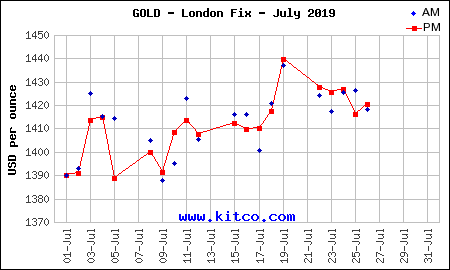
30-day Gold Chart (will not update—Courtesy of Kitco)
For numismatics, the rising price of silver can be problematics. As the price of silver rises, the value of your coins will increase. However, adding to your collection will cost more, especially on those collectible coins whose value is tied to the price of silver.
Those responsible for investing in these markets are beginning to worry. If investors are buying silver as a safe haven, there could be a feeling of a pending economic crisis. Only time will tell if they are right.
And now the news…
Present-day tenants of home owned by Jewish family before the Holocaust find jars containing 2,800 coins from as far back as the Roman Empire and as far away as India  → Read more at timesofisrael.com
→ Read more at timesofisrael.com
A hoard of Roman coins dating from the time of Queen Boudicca have been found by a metal detectorist in a field. What makes this find especially fascinating is that they may have been hidden there during one of the most interesting periods in Britain’s early history, the revolt against Rome led by the Celtic Queen Boudicca.  → Read more at thevintagenews.com
→ Read more at thevintagenews.com
Silver futures settle at a 13-month high on Monday, outpacing strength in gold, which saw prices eke out only a modest gain despite rising tensions between…  → Read more at marketwatch.com
→ Read more at marketwatch.com
Happy Anniversary to Modern Coinage
The act forbade the striking of silver dollars for five years ending an experiment with the striking of Peace Dollars in 1964. There are rumors that at least one 1964-D Peace exists despite the U.S. Mint’s insistence that all of the coins were melted.
Finally, the act made all coins and currency produced in the United States and specific bank issues as legal tender, which reversed the demonetization of the Trade Dollar in 1867.
The Coinage Act of 1965 marks the dividing line between “classic” and “modern” coinage.
After fifty-four years of modern coinage, there continues to be collectors and dealers who turn up their noses at modern coins.
Although the stories behind many of the classic issues are interesting, modern coins provide a diversity that is meaningful and affordable for the average collector.
The first coin of the modern era that had a public impact was the dual-dated coins with the reverses honoring the nation’s bicentennial. The bicentennial was a two-year celebration preceded by three years of hype and prep. When the coins were released, many people searched their change, looking for the coins. It was the first time in many years that half-dollar and large dollar coins circulated in significant numbers since finding them in change was exciting.
The modern era also saw a big flop when the Susan B. Anthony small dollar coin entered circulation. Even though the U.S. Mint tried to simulate the 12-sides on the coin’s design, the size and the reeded edge was confused with the quarter. People stopped using the Susie B. thus ending whatever momentum dollar coins had.The most successful program of the modern era was the 50 State Quarters program. The program started strong with a lot of interest. Unfortunately, a downturn in the economy and the television hucksters overselling the potential value of the series turned away a lot of potential collectors.
As the success of the 50 State Quarters program grew, Congress passed laws to create several other circulating commemoratives. The programs include the Westward Journey Nickels, Abraham Lincon Bicentennial cents, and the Native American $1 coin program using the golden-colored planchets of the Sacagawea dollar.
The modern era saw the return of the commemorative coin programs. Some were very popular, like the 2001 American Buffalo Commemorative Coin and 2014 National Baseball Hall of Fame Commemorative Coin programs. There were less popular coins, but none had flopped as bad as the 2013 Girl Scouts of the USA Centennial Silver Dollar.
Unlike previous commemorative coin laws, modern laws help the U.S. Mint limit the time these coins can remain on sale. It also limits their production to one year.
Finally, the modern era has given us the bullion coin series. It started with the American Silver Eagle program that was created to provide a way for the United States government to sell off silver saved in the Defense National Stockpile. As a result, the U.S. Mint has used the program to experiment with different finishes, including burnished and reverse proof.
Congress passed the Gold Bullion Coin Act of 1985 a few months later after being lobbied by the gold mining interests. This law created the American Eagle Gold Bullion Program.
Even more significant was Title II of the Presidential $1 Coin Act of 2005. Title II established the American Buffalo 24-Karat Bullion Gold Coins program. The law required the coins struck from .9999 put gold using the design of the 1913 Type 1 Buffalo Nickel as designed by James Earle Fraser. After the first year of issue, the U.S. Mint could change the design after vetting the design with the Commission of Fine Arts and the Citizens Coinage Advisory Committee. This law allowed the U.S. Mint to produce coins like the 2009 High Relief gold coin and the 100th-anniversary tributes to the Mercury dime in 2016.After 54 years there are a lot of exciting choices for the modern collector. And this does not consider the collection of errors or varieties, like the three types of 1972 Eisenhower dollars or the wide versus narrow lettering on the reverse of the 1999 Lincoln cent.
It is past the time for the numismatic community to embrace the collection of modern coins more than it has. There may be few modern coins that are worth thousands of dollars, but they are available to capture the interest of potential collectors. After all, how many of us started collecting by searching pocket change.
Weekly World Numismatic News for July 21, 2019
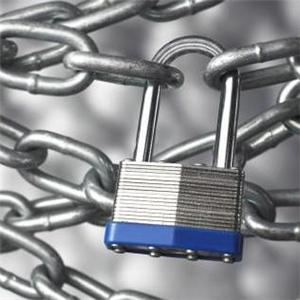 While there was plenty of news this week, I want to take this opportunity to use myself as an example. Some may have noticed that the blog was taken down for a little more than a day earlier this week. The downtime was necessary to clean up after my account was attacked.
While there was plenty of news this week, I want to take this opportunity to use myself as an example. Some may have noticed that the blog was taken down for a little more than a day earlier this week. The downtime was necessary to clean up after my account was attacked.
The attack occurred after I had given the person who is maintaining my company’s website the administrative passwords. Although that person did not attack my account, the use of compromised services on the Internet allowed the attack to happen.
Being attacked by malware on the Internet is nothing new. I am sure that most of you experienced an attack either of a website, your email, or social media account. The clean up is not fun. The embarrassment after spending a career as an information security profession is enormous.
I do pay attention to my version of the world to make sure that what I am involved with does not cause problems. Even so, something got passed my watch and infected my entire account, including this blog and the news site.
I have written about security issues in the past. As my experience has shown, letting down your guard can lead to an unintentional disaster.
I know that Internet security is both problematic and annoying. Having to watch over your virtual shoulders can make the time you spend online unpleasant. But it has to be done. You have to stay aware because the threats adapt as you do.
Fans of Hill Street Blues will remember that after the morning briefing, Sergeant Phil Esterhaus would say, “Let’s be careful out there.” Sound advice for the Internet age.
And now the news…
London (CNN Business)Alan Turing, a crack code-breaker and visionary mathematician who was convicted under Victorian-era homophobic laws, will be the face of Britain's new £50 note. Bank of England Governor Mark Carney announced Monday that Turing, who killed himself in 1954 after he was subjected to chemical castration, will appear on the new polymer note by the end of 2021.  → Read more at cnn.com
→ Read more at cnn.com
Nick Vorsin wasn’t sure what he’d find when he stopped in at the Calgary Coin Gallery, but he ended up buying a couple of nice surprises: two 1967 Canadian Centennial coins. One was a 50 cent piece, featuring an image of a howling wolf, along with a silver dollar featuring a Canada goose.  → Read more at globalnews.ca
→ Read more at globalnews.ca
(UPDATED) A study finds that Filipinos frequently use P20 bills, leading to the banknote's wear and tear. A coin version will extend its life span. MANILA, Philippines (UPDATED) – The orange P20 bill will soon get a coin counterpart, an official of the Bangko Sentral ng Pilipinas (BSP) said on Wednesday, July 17.  → Read more at rappler.com
→ Read more at rappler.com
Before you say, "Keep the change," make sure you don’t have one of these. You never know, one of your pennies could be worth the price of a nice dinner out — or maybe a whole lot more.  → Read more at cnbc.com
→ Read more at cnbc.com
Richard Hayes left a $45 million coin on the streets of Manhattan all day Tuesday, but he wasn’t particularly worried about a thief carting it off.  → Read more at marketwatch.com
→ Read more at marketwatch.com
Rusty Goe has spent much of his professional life on a deep dive into the history of the U.S. Mint in Carson City. He’s written multiple books on the subject and spent thousands of hours in research, getting to know the people who worked there 150 years ago.  → Read more at carsonnow.org
→ Read more at carsonnow.org
There was an increase in hoarding coins during the "tumultuous" reign of the queen, an expert says.  → Read more at bbc.com
→ Read more at bbc.com
